
Sparidae is a family of ray-finned fishes belonging to the order Spariformes, the sea breams and porgies, although they were traditionally classified in the order Perciformes. They are found in shallow temperate and tropical waters around the world and are demersal carnivores.
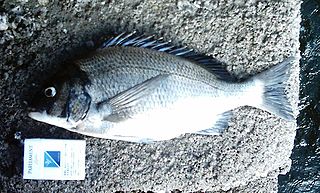
Acanthopagrus schlegelii, the blackhead seabream, black porgy or black seabream, is a species of marine ray-finned fish belonging to the family Sparidae, the seabreams and porgies. This species is found in the Western Pacific Ocean. The blackhead seabream is an important species in commercial fisheries, particularly in Vietnam.

The common pandora, also known as king of the breams, pandorared pandora or Spanish seabream, is a species of marine ray-finned fish belonging to the family Sparidae, which includes the seabreams and porgies. This fish is found in the eastern Atlantic Ocean and the Mediterranean Sea. It is an esteemed food fish.

Pagrus is a genus of marine ray-finned fishes belonging to the family Sparidae, which includes the seabreams and porgies. These fishes are found in the Western Pacific Ocean, Atlantic Ocean and Mediterranean Sea. They are esteemed food fishes which are targeted by commercial fisheries and are grown in aquaculture.

The black seabream is a species of marine ray-finned fish belonging to the family Sparidae, which includes the seabreams and porgies. This fish has a wide distribution in the eastern Atlantic Ocean and the Mediterranean and Black Seas. The black seabream is an important food fish, especially in Europe.
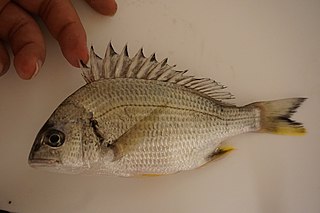
Acanthopagrus latus, the yellowfin seabream, grey bream, Houttuyn's yellowfin seabream, Japanese bream or yellow-finned black porgy, is a species of marine ray-finned fish belonging to the family Sparidae, the seabreams and porgies. This fish is found in the Western Pacific Ocean.

The saddled seabream, also called the saddle bream or oblade, is a species of ray-finned fish belonging to the family Sparidae, which includes the seabreams and porgies. It is the only species in the monospecific genus Oblada. This species is found in the Eastern Atlantic Ocean. It is an important food fish within its range.

Diplodus sargus, the sargo, common white seabream, or white seabream is a species of marine ray-finned fish belonging to the family Sparidae, which includes the seabreams and porgies. This fish is found in the eastern Atlantic Ocean and in the Mediterranean Sea. It is a target species for commercial fisheries and is grown in aquaculture. D. sargussensu lato was formerly thought to be a widespread species in the eastern Atlantic and western Indian Oceans but the taxa outside of D, sargussensu stricto are now recognised as valid species and are part of the D. sargus species complex.
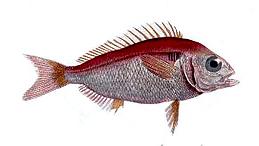
The blackspot seabream, also known as the red seabream and as the besugo, is a species of marine ray-finned fish belonging to the family Sparidae, which includes the seabreams and porgies. This is a widespread species in the Eastern Atlantic from Norway to Mauritania, including Macaronesia and the western Mediterranean. It is an important species to fisheries, although overfishing has led to this species being classified as Near Threatened.

Diplodus vulgaris, the common two-banded sea bream, is a species of marine ray-finned fish belonging to the family Sparidae, which includes the seabreams and porgies. This species is found in the northeastern Atlantic Ocean and the Mediterranean. It is an important species for fisheries and is grown in aquaculture.

Rhabdosargus sarba, also known as the goldlined seabream, silver bream, tarwhine, or yellowfin bream, is a species of marine ray-finned fish belonging to the family Sparidae, which includes the seabreams and porgies. This fish has a wide [[Indo-Pacific distribution.

Diplodus cervinus, the zebra sea bream, is a species of marine ray-finned fish belonging to the family Sparidae, which includes the seabreams and porgies. This species is found in the temperate north eastern Atlantic Ocean and the Mediterranean Sea.

Acanthopagrus berda, the goldsilk seabream, sly bream, picnic seabream, black sea bream, black porgy, picky bream, silver bream or river bream, is a species of ray-finned fish belonging to the family Sparidae, the sea breams and porgies. This species is found in the Indian Ocean.

Sparicotyle chrysophrii is a species of monogenean, parasitic on the gills of the marine fish. It belongs to the family Microcotylidae. Its type-host is the gilt-head seabream.

Diplodus annularis, the annular seabream is a species of marine ray-finned fish belonging to the family Sparidae, the family which includes the seabreams and porgies. This species is found in the Eastern Atlantic Ocean and Mediterranean.

Pagellus acarne, the axillary seabream or Spanish seabream is a species of marine ray-finned fish belonging to the family Sparidae, which includes the seabreams and porgies. This fish is found in the eastern Atlantic Ocean and Mediterranean Sea.
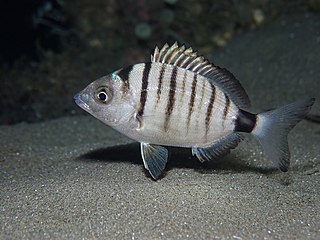
Diplodus puntazzo, the sharpsnout seabream, sheephead bream or puntazzo, is a species of marine ray-finned fish belonging to the family Sparidae, which includes the seabreams and porgies. This species is found in the, Eastern Atlantic and the Mediterranean and Black Seas. This omnivorous fish is an important species for aquaculture and fisheries, despite the flesh not being highly esteemed.
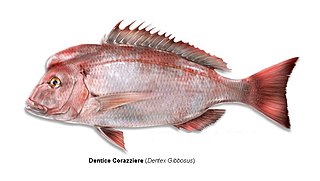
The pink dentex is a species of marine ray-finned fish belonging to the family Sparidae, a family that includes the seabreams and porgies. This species is found in the temperate and tropical waters of the eastern Atlantic Ocean and the Mediterranean Sea.

Evynnis cardinalis, the threadfin porgy or cardinal seabream, is a species of marine ray-finned fish belonging to the family Sparidae, which includes the seabreams and porgies. This fish is found in the Western Pacific Ocean off the coasts of Eastern Asia. It is an important food fish but is classified by the IUCN as Endangered.

Evynnis tumifrons, the yellowback seabream, crimson seabream, goldentail or red seabream, is a species of marine ray-finned fish belonging to the family Sparidae, which includes the seabreams and porgies. This fish is found in the Western Pacific Ocean off the coasts of East Asia. This species is an important food fish in the East China Sea and Japan.




























